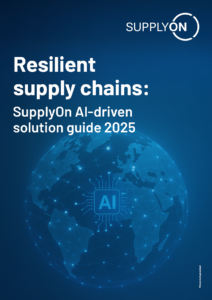2024 — the year of change
![[picture: runner in starting position] There are 10 key factors for successful supply chain digital transformation in 2024 and beyond](https://cdn.supplyon.com/wp-content/uploads/2024/02/2024-year-of-change_LinkedIn_Blog_1200x627px_blog-teaser.jpg)
Like most people this year, I had every intention of writing about the New Year in January, but honestly, the busyness of last year never stopped; it carried over not only from last year, but from 2022, through the holidays, and into this year. Now I feel like I blinked and landed in February. It seems only fitting to write about this new year during the Lunar New Year, especially since this is the Year of the Dragon. Dragons are a revered symbol of power and thought. It is considered the luckiest sign in the Chinese Zodiac. If you know me, then you know my pension for dragons. This year, the mythical creature is paired with the element of wood, which is said to bring good fortune, action and growth. What better way to get started on my old 2020 goals that have reemerged from lockdown and new goals than to blaze a new trail on the heels of a fierce dragon?
After the pandemic crisis came to a screeching halt, organizations had to scramble and implement stopgap measures just to get by. When we emerged from the pandemic in 2021, it was paralyzing, with an uncertain world around us while we figured out the new normal. In 2022, organizations began to share more about the challenges they were facing and put effort into understanding new ideas and solutions that could change their current state. In 2023, I saw organizations get more serious about change, especially around digital transformation strategies and initiatives. Now, finally, 2024 is the year when organizations will be driven to change.
10 success factors for digital supply chain transformation
Here are my mission-critical, key factors for successful supply chain digital transformation in 2024 and beyond:
- True leadership: Digital transformation is more than a one-time mandate from headquarters; it is a true commitment. It requires an ongoing effort from a C-level leader to not only educate and drive this change, but also to bring their best street fighting skills and rocket science thinking cap to ultimately make the change happen.
- Strong team: Assemble the best teams that get it and share the vision, passion, and drive to work together to understand and document the current situation, research solutions, build a business case, plan deployment, lead internal and external change management, launch, and work to continually improve processes and the solution.
- Partnership: Digital transformation is an investment in every sense of the word. The right supply chain collaboration tool is a complex solution that connects data from multiple data points. It requires analysis, planning, design, mapping, configuration, testing, and training. To make this transformation a success, it’s critical to choose a solution provider that can guide, educate, support, and share your vision and mission. One that will be with you before, during and after.
- Be open: With any type of change, it’s critical to be open to different ideas, processes, and solutions. The digital world moves at lightning speed and has changed for the better. It can be hard not to get stuck in the past with old technology that maybe didn’t work well and outdated concepts that are no longer relevant. Step back, explore, and look at the big picture to find a new way.
- Understand ROI: Return in Investment (ROI) is both tangible and intangible. It will also vary from one organization to the next. There is no quick ROI answer for a solution; it’s going to take some work to build it so it’s real and measurable. For the tangible part, the starting point must come from existing data and be aligned with financial goals. For example, simple goals might be to reduce inventory or emergency freight costs. This is easy enough to do the math with current costs and then figure out the reduction targets. The intangible ROI can be much harder to measure, but the benefits can be more impactful. For example, reducing manual effort could result in a happier team that can be proactive rather than reactive, which in turn could result in better planning, optimized build schedules, less overtime, better pricing, less downtime, more on-time deliveries, and some very surprising cost savings. For the intangible ROI, talk to your team and create an estimate. Then align that with some of their goals.
- Budget: Digital transformation is an investment and requires money to make it happen. A realistic budget with a twenty percent contingency is optimal. It’s also critical to look beyond the annual fee for the solution and understand that there are not only external implementation costs, but also internal resources required to implement new solutions, such as a one-to-one ratio of days from your solution provider. It’s also important to know what’s really included in the package beyond the bottom line price tag. Also, do not forget to budget for change management if you want the project to be successful.
- Change Management: Implementing a new solution without a change management strategy is like buying a car without wheels and expecting it to go anywhere. Change management requires a solid plan that includes clear goals and messaging, an internal and external portal with information, training and progress. It requires a strong kick-off presentation from leadership and an ongoing, scalable dialogue both internally and externally with stakeholders.
- The right solution: Finding the right solution and tools takes some time and research. Make sure it meets your current needs, but is also scalable for your future. Configurable is definitely better than custom, as the latter can turn into something that cannot be updated later. Continual enhancements and updates are also a plus to avoid painful and costly migrations in the future. Make sure it works with any ERP and 3rd party solution. It should have plenty of support options. Most importantly, it should be easy to use—after all, it’s no good if it’s not used.
- Realistic goals: While there is an urgency to digital transformation, the process takes time and internal teams are working on this mission in addition to their full-time jobs. Depending on the day-to-day business, the research phase alone can have many starts and stops. Planning, budgets, internal approvals, legal, alignment, and preparation can also be delayed. Faster isn’t better if the solution isn’t right, the implementation isn’t done right, and the whole project lacks change management.
- Solid roadmap: It’s easy to get excited and geeked out about digital transformation. Don’t skip the planning stages. Create a solid roadmap for your journey, and know that it’s okay to make mid-course corrections if necessary. Be flexible, open and mindful.
2024! Ready. Set. Go in like a dragon.




